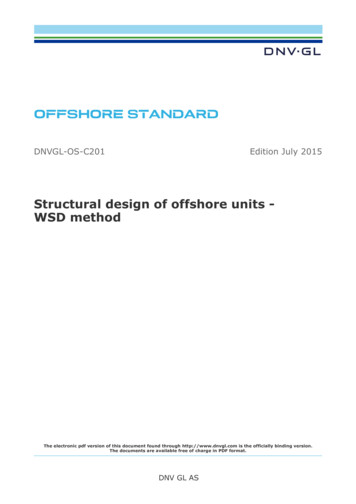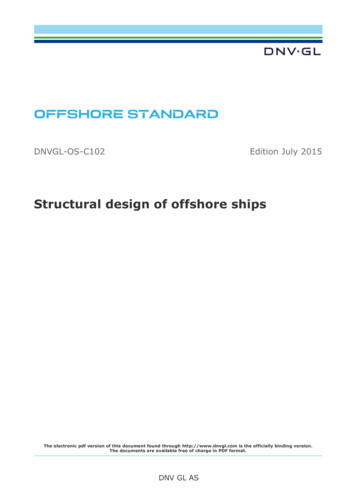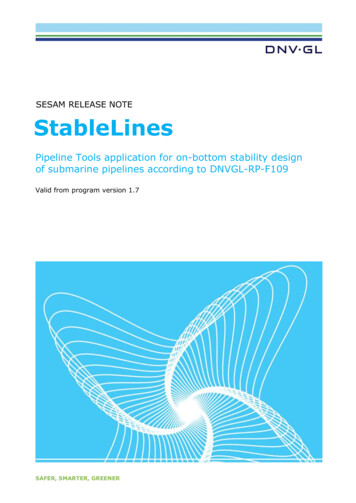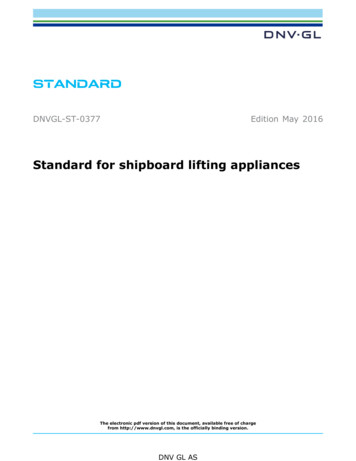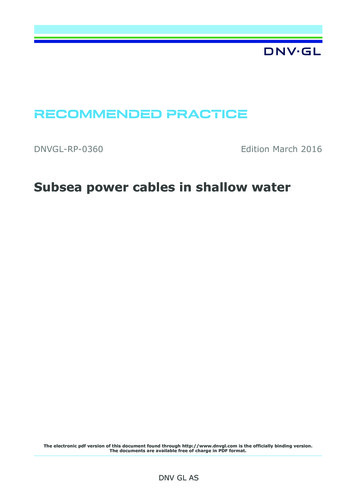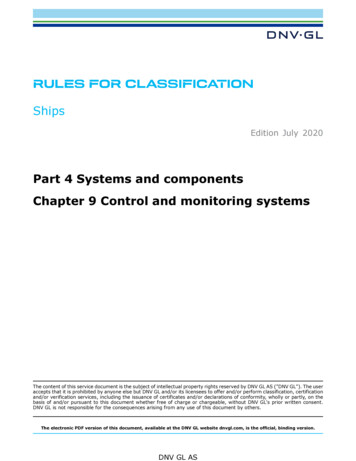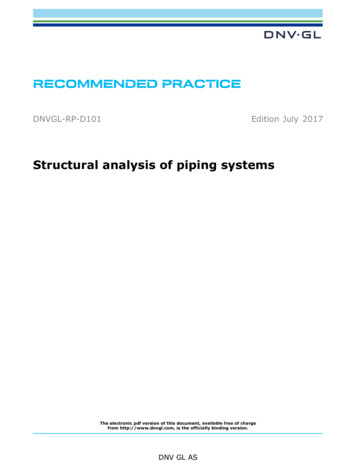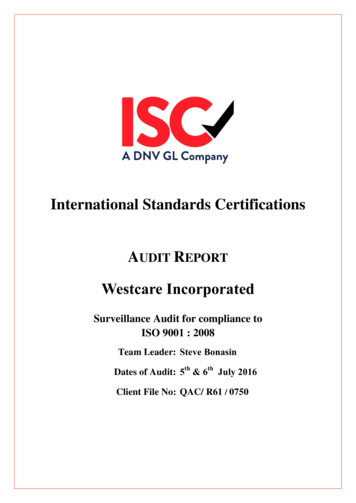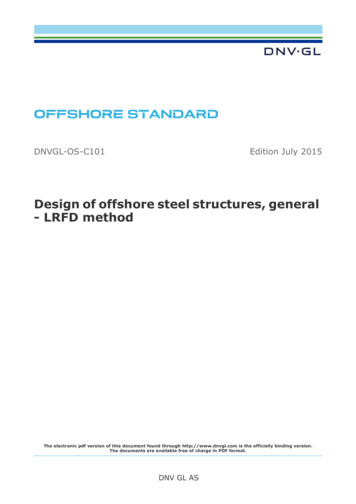
Transcription
OFFSHORE STANDARDDNVGL-OS-C101Edition July 2015Design of offshore steel structures, general- LRFD methodThe electronic pdf version of this document found through http://www.dnvgl.com is the officially binding version.The documents are available free of charge in PDF format.DNV GL AS
FOREWORDDNV GL offshore standards contain technical requirements, principles and acceptance criteria related toclassification of offshore units. DNV GL AS July 2015Any comments may be sent by e-mail to rules@dnvgl.comThis service document has been prepared based on available knowledge, technology and/or information at the time of issuance of this document. The use of thisdocument by others than DNV GL is at the user's sole risk. DNV GL does not accept any liability or responsibility for loss or damages resulting from any use ofthis document.
GeneralThis document supersedes DNV-OS-C101, July 2014.Text affected by the main changes in this edition is highlighted in red colour. However, if the changesinvolve a whole chapter, section or sub-section, normally only the title will be in red colour.On 12 September 2013, DNV and GL merged to form DNV GL Group. On 25 November 2013 Det NorskeVeritas AS became the 100% shareholder of Germanischer Lloyd SE, the parent company of the GL Group,and on 27 November 2013 Det Norske Veritas AS, company registration number 945 748 931, changed itsname to DNV GL AS. For further information, see www.dnvgl.com. Any reference in this document to “DetNorske Veritas AS”, “Det Norske Veritas”, “DNV”, “GL”, “Germanischer Lloyd SE”, “GL Group” or any otherlegal entity name or trading name presently owned by the DNV GL Group shall therefore also be considereda reference to “DNV GL AS”.Main changes GeneralThe revision of this document is part of the DNV GL merger, updating the previous DNV standard into a DNVGL format including updated nomenclature and document reference numbering, e.g.:— Main class identification 1A1 becomes 1A.— DNV replaced by DNV GL.— DNV-RP-A201 to DNVGL-CG-0168. A complete listing with updated reference numbers can be found onDNV GL's homepage on internet.To complete your understanding, observe that the entire DNV GL update process will be implementedsequentially. Hence, for some of the references, still the legacy DNV documents apply and are explicitlyindicated as such, e.g.: Rules for Ships has become DNV Rules for Ships.Editorial correctionsIn addition to the above stated main changes, editorial corrections may have been made.Offshore standard, DNVGL-OS-C101 – Edition July 2015Design of offshore steel structures, general - LRFD methodDNV GL ASPage 3Changes – currentCHANGES – CURRENT
CHANGES – CURRENT . 3CH. 1 INTRODUCTION . 9Sec.1Introduction . 91General .91.1 Introduction.91.2 Objectives .91.3 Scope and application .91.4 Other than DNV GL codes . 101.5 Classification. 102References.102.1 General . 103Definitions .113.1 Verbal forms . 113.2 Terms . 114Abbreviations and symbols .144.1 Abbreviations . 144.2 Symbols . 15CH. 2 TECHNICAL CONTENT. 17Sec.1Sec.2Design principles. 171Introduction .171.1 General . 171.2 Aim of the design . 172General design considerations .172.1 General . 173Limit states.183.1 General . 184Design by LRFD method .194.1 General . 194.2 The load and resistance factor design format (LRFD) . 194.3 Characteristic load . 204.4 Load factors for ULS. 204.5 Load factor for FLS . 214.6 Load factor for SLS . 214.7 Load factor for ALS . 215Design assisted by testing .215.1 General . 215.2 Full-scale testing and observation of performance of existing structures . 216Probability based design.226.1 Definition . 226.2 General . 22Loads and load effects. 231Introduction .231.1 General . 231.2 Scope . 23Offshore standard, DNVGL-OS-C101 – Edition July 2015Design of offshore steel structures, general - LRFD methodDNV GL ASPage 4ContentsCONTENTS
Sec.3Basis for selection of characteristic loads .232.1 General . 233Permanent loads (G) .243.1 General . 244Variable functional loads (Q) .244.1 General . 244.2 Variable functional loads on deck areas. 244.3 Tank pressures. 254.4 Lifeboat platforms. 265Environmental loads (E) .265.1 General . 265.2 Environmental loads for mobile offshore units. 265.3 Environmental loads for site specific units . 265.4 Determination of characteristic hydrodynamic loads . 275.5 Wave loads . 275.6 Wave induced inertia forces . 285.7 Wind loads . 285.8 Vortex induced oscillations . 285.9 Current . 285.10 Tidal effects . 295.11 Marine growth . 295.12 Snow and ice accumulation . 295.13 Direct ice load . 295.14 Water level, settlements and erosion . 295.15 Earthquake . 296Combination of environmental loads .306.1 General . 307Accidental loads (A) .317.1 General . 318Deformation loads (D) .318.1 General . 318.2 Temperature loads. 318.3 Settlements and subsidence of sea bed . 319Load9.19.29.3effect analysis .32General . 32Global motion analysis . 32Load effects in structures and soil or foundation . 32Structural categorisation, material selection and inspection principles . 341Scope.342Temperatures for selection of material .342.1 General . 342.2 Floating units . 342.3 Bottom fixed units . 343Structural category .343.1 General . 343.2 Selection of structural category . 353.3 Inspection of welds . 354Structural steel .364.1 General . 364.2 Material designations . 364.3 Selection of structural steel. 38Offshore standard, DNVGL-OS-C101 – Edition July 2015Design of offshore steel structures, general - LRFD methodDNV GL ASPage 5Contents2
Sec.4Sec.5Ultimate limit states. 401General .401.1 General . 401.2 Structural analysis . 401.3 Ductility . 401.4 Yield check . 411.5 Buckling check . 412Flat plated structures and stiffened panels .422.1 General . 422.2 Yield check . 422.3 Buckling check . 422.4 Capacity checks according to other codes . 423Shell structures .423.1 General . 424Tubular members, tubular joints and conical transitions .434.1 General . 435Non-tubular beams, columns and frames.435.1 General . 436Special provisions for plating and stiffeners .436.1 Scope . 436.2 Minimum thickness . 446.3 Bending of plating . 446.4 Stiffeners . 447Special provisions for girder and girder systems .457.1 Scope . 457.2 Minimum thickness . 457.3 Bending and shear . 457.4 Effective flange . 467.5 Effective web . 467.6 Strength requirements for simple girders . 467.7 Complex girder system. 488Slip resistant bolt connections.488.1 General . 48Fatigue limit states . 511Sec.6General .511.1 General . 511.2 Design fatigue factors . 511.3 Methods for fatigue analysis. 52Accidental limit states . 531Sec.7Fracture mechanics testing . 39Post weld heat treatment. 39General .531.1 General . 53Serviceability limit states . 541General .541.1 General . 541.2 Deflection criteria . 541.3 Out of plane deflection of local plates . 55Offshore standard, DNVGL-OS-C101 – Edition July 2015Design of offshore steel structures, general - LRFD methodDNV GL ASPage 6Contents4.44.5
Weld connections . 561General .562Types of welded steel joints .562.1 Butt joints . 562.2 Tee or cross joints . 562.3 Slot welds. 572.4 Lap joint. 583Weld3.13.23.33.43.53.6Sec.9size .58General . 58Fillet welds . 59Partly penetration welds and fillet welds in cross connections subjectto high stresses. 59Connections of stiffeners to girders and bulkheads etc. . 60End connections of girders . 62Direct calculation of weld connections. 62Corrosion control . 641Introduction .642Techniques for corrosion control related to environmental zones.642.1 Atmospheric zone . 642.2 Splash zone . 642.3 Submerged zone . 652.4 Internal zones . 653Cathodic protection .663.1 General . 663.2 Galvanic anode systems . 673.3 Impressed current systems . 674Coating systems .684.1 Specification of coating. 68Sec.10 Foundation design. 691General .691.1 Introduction. 691.2 Site investigations . 701.3 Characteristic properties of soil. 701.4 Effects of cyclic loading . 711.5 Soil-structure interaction . 712Stability of seabed .722.1 Slope stability . 722.2 Hydraulic stability . 722.3 Scour and scour protection . 723Design of pile foundations .733.1 General . 733.2 Soil resistance against axial pile loads . 743.3 Soil resistance against lateral pile loads . 743.4 Group effects . 744Design of gravity foundations .754.1 General . 754.2 Stability of foundations. 754.3 Settlements and displacements . 764.4 Soil reaction on foundation structure . 764.5 Soil modelling for dynamic analysis . 764.6 Filling of voids . 76Offshore standard, DNVGL-OS-C101 – Edition July 2015Design of offshore steel structures, general - LRFD methodDNV GL ASPage 7ContentsSec.8
Design of anchor foundations .775.1 General . 775.2 Safety requirements for anchor foundations . 775.3 Pile anchors . 785.4 Gravity anchors . 785.5 Suction anchors. 785.6 Fluke anchors. 805.7 Plate anchors . 80CH. 3 CLASSIFICATION AND CERTIFICATION. 81Sec.1Classification. 811General .811.1 Introduction. 811.2 Application. 811.3 Documentation. 81APP. A CROSS SECTIONAL TYPES . 821Cross sectional types .821.1 General . 821.2 Cross section requirements for plastic analysis . 821.3 Cross section requirements when elastic global analysis is used . 83Offshore standard, DNVGL-OS-C101 – Edition July 2015Design of offshore steel structures, general - LRFD methodDNV GL ASPage 8Contents5
SECTION 1 INTRODUCTION1 General1.1 Introduction1.1.1 This offshore standard provides principles, technical requirements and guidance for the structuraldesign of offshore structures.1.1.2 DNVGL-OS-C101 is the general part of the DNV GL Offshore Standards for structures. The designprinciples and overall requirements are defined in this standard. The standard is primarily intended to beused in design of a structure where a supporting object standard exists, but may also be used as a standalone document for objects where no object standard exist.1.1.3 When designing a unit where an object standard exists, the object standard (DNVGL-OS-C10x) forthe specific type of unit shall be applied. The object standard gives references to this standard whenappropriate.1.1.4 In case of deviating requirements between this standard and the object standard, requirements ofthis standard shall be overruled by specific requirements given in the object standard.1.1.5 This standard has been written for general world-wide application. Governmental regulations mayinclude requirements in excess of the provisions by this standard depending on size, type, location andintended service of the offshore unit or installation.1.2 ObjectivesThe objectives of this standard are to:— provide an internationally acceptable level of safety by defining minimum requirements for structuresand structural components (in combination with referred standards, recommended practices,guidelines, etc.)— serve as a contractual reference document between suppliers and purchasers— serve as a guideline for designers, suppliers, purchasers and regulators— specify procedures and requirements for offshore structures subject to DNV GL certification andclassification.1.3 Scope and application1.3.1 The standard is applicable to all types of offshore structures of steel.1.3.2 For other materials, the general design principles given in this standard may be used together withrelevant standards, codes or specifications.1.3.3 The standard is applicable to the design of complete structures including substructures, topsidestructures, vessel hulls and foundations.1.3.4 This standard gives requirements for the following:— design principles— structural categorisation— material selection and inspection principles— design loads— load effect analyses— design of steel structures and connections— corrosion protection— foundation design.Offshore standard, DNVGL-OS-C101 – Edition July 2015Design of offshore steel structures, general - LRFD methodDNV GL ASPage 9Chapter 1 Section 1CHAPTER 1 INTRODUCTION
1.4.1 In case of conflict between the requirements of this standard and a reference document other thanDNV GL documents, the requirements of this standard shall prevail.1.4.2 Where reference is made to codes other than DNV GL documents, the latest revision of thedocuments shall be applied, unless otherwise specified.1.4.3 When code checks are performed according to other than DNV GL codes, the resistance or materialfactors as given in the respective code shall be used.1.5 ClassificationDocumentation for classification shall be in accordance with the NPS DocReq (DNV GL Nauticus ProductionSystem for documentation requirements) and DNVGL-CG-0168.2 References2.1 General2.1.1 The DNV GL documents in Table 1 and Table 2 and recognised codes and standards in Table 3 arereferred to in this standard.2.1.2 The latest valid revision of the DNV GL reference documents in Table 1 and Table 2 applies. Theseinclude acceptable methods for fulfilling the requirements in this standard. See also current DNV GL List ofPublications.2.1.3 When designing a unit where an object standard exists, the object standard for the specific type ofunit shall be applied, see Table 2. The object standard gives references to this standard when appropriate,see also [1.1.3] and [1.1.4].2.1.4 Other recognised codes or standards may be applied provided it is shown that they meet or exceedthe level of safety of the actual DNV GL Offshore Standard.Table 1 DNV GL and DNV reference documentsReferenceTitleDNVGL-OS-A101Safety principles and arrangementDNVGL-OS-B101Metallic materialsDNVGL-OS-C401Fabrication and testing of offshore structuresDNVGL-OS-E301Position mooringDNV-OS-H101Marine Operations, GeneralDNVGL-CG-0168Plan approval documentation types – definitionsDNV-RP-B401Cathodic Protection DesignDNVGL-RP-C201Buckling strength of plated structuresDNV-RP-C202Buckling Strength of ShellsDNVGL-RP-C203Fatigue strength analysis of offshore steel structuresDNV-RP-C204Design against Accidental LoadsDNV-RP-C205Environmental Conditions and Environmental LoadsDNV-RP-E301Design and Installation of Fluke Anchors in ClayDNV-RP-E302Design and Installation of Plate Anchors in ClayDNV-RP-E303Geotechnical Design and Installation of Suction Anchors in ClayDNV Classification Note 30.1Buckling Strength Analysis of Bars and Frames, and Spherical Shells, Sec.2 Bars andFramesDNV Classification Note 30.4FoundationsDNV Classification Note 30.6Struct
design of offshore structures. 1.1.2 DNVGL-OS-C101 is the general part of the DNV GL Offshore Standards for structures. The design principles and overall requirements are defined in this standard. The standard is primarily intended to be used in design of a structure where a supporting

